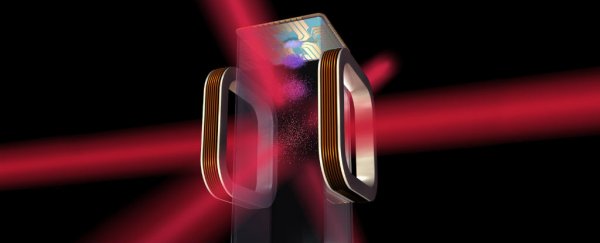NASA is about to launch the coldest place on Earth - the Cold Atom Laboratory (CAL) - into orbit, where astronauts will use it to create never-before-seen conditions with temperatures 100 million times colder than the depths of space.
The Cold Atom Lab will hitch a ride on a SpaceX rocket to the International Space Station, where it's hoped the super-chilled box will reveal strange new physics when atoms are cooled to a mere billionth of a degree above absolute zero.
"Studying these hyper-cold atoms could reshape our understanding of matter and the fundamental nature of gravity," said CAL project scientist Robert Thompson, from NASA's Jet Propulsion Laboratory.
"The experiments we'll do with the Cold Atom Lab will give us insight into gravity and dark energy - some of the most pervasive forces in the Universe."
In case you've never considered what the coldest place on Earth was until about 30 seconds ago, NASA's Cold Atom Laboratory is an ice chest-sized box equipped with lasers, a vacuum chamber, and an electromagnetic 'knife' to slow particles to an almost motionless state.
The instrument is still in its final stages of construction, so this mission, set to launch in August, will be its first big test.
The plan is to fill the Cold Atom Lab with gas particles aboard the International Space Station, where the unique microgravity environment will allow researchers to observe never-before-seen quantum phenomena that are impossible to detect on Earth.
Of particular interest is the exotic form of matter called Bose-Einstein condensate - a 'superfluid' state where atoms morph into mysterious waveforms that have never been observed at Cold Atom Lab temperatures.
Because this state has zero viscosity, atoms are able to move without friction, as if they were a single, solid substance, NASA explains.
"If you had superfluid water and spun it around in a glass, it would spin forever," says Anita Sengupta, the Cold Atom Lab project manager.
"There's no viscosity to slow it down and dissipate the kinetic energy. If we can better understand the physics of superfluids, we can possibly learn to use those for more efficient transfer of energy."
Bose-Einstein condensates are of particular interest to physicists because in this state, the rules switch from classical physics - such as Einstein's theory of general relativity - to quantum physics, and matter starts to behave less like particles and more like waves.
Understanding this transition is the key to one of the biggest open questions in modern physics - when used separately, general relativity and quantum field theory can explain the largest and smallest things in the Universe respectively, but no physicist has ever managed to unify the two into a much-coveted 'theory of everything'.
For that reason, physicists would love to stare at Bose-Einstein condensates for days, but because Earth's gravitational pull puts a swift end to the free fall state necessary to maintain this exotic matter, it's usually only observable for a few fractions of a second.
In the microgravity environment of space, however, scientists should be able to get a much more substantial view of things - NASA predicts they'll be able to maintain Bose-Einstein condensates in the Cold Atom Lab for up to 5 to 10 seconds in space.
Not only could this help us figure out what binds classical and quantum physics together, but a better understanding of Bose-Einstein condensates could lead to more accurate sensors, telescopes, and the atomic clocks used in spacecraft navigation, and could even speed up the race towards the world's first quantum computer.
"Like a new lens in Galileo's first telescope, the ultra-sensitive cold atoms in the Cold Atom Lab have the potential to unlock many mysteries beyond the frontiers of known physics," says Kamal Oudrhiri, deputy project manager of the CAL.
Hurry up, August - we need to see this thing in action!
